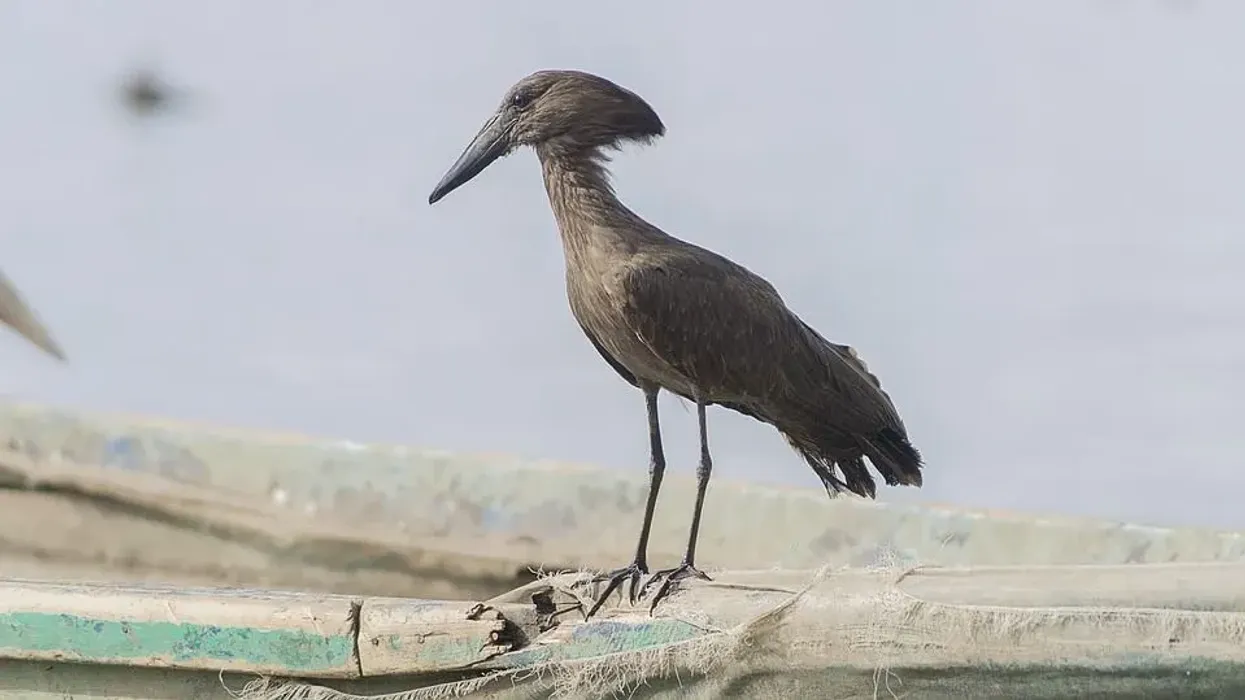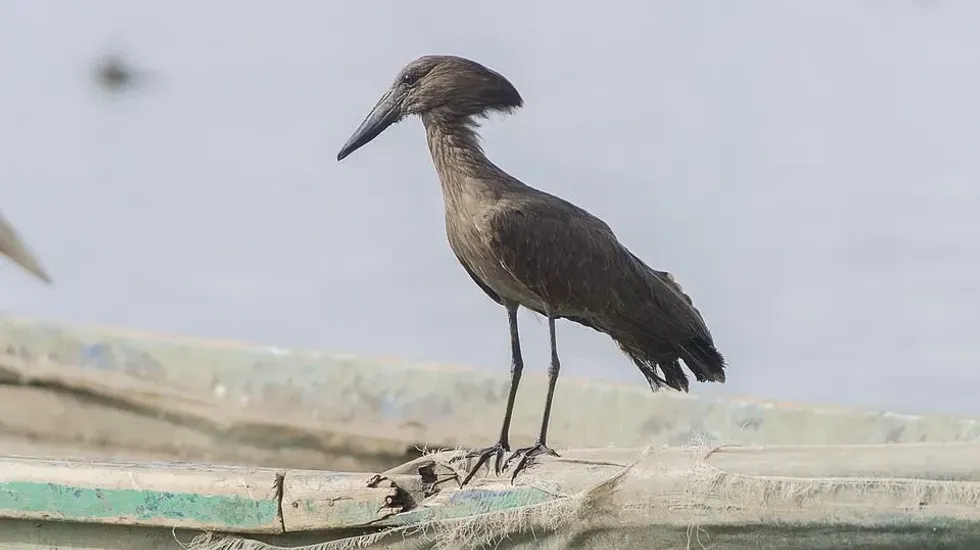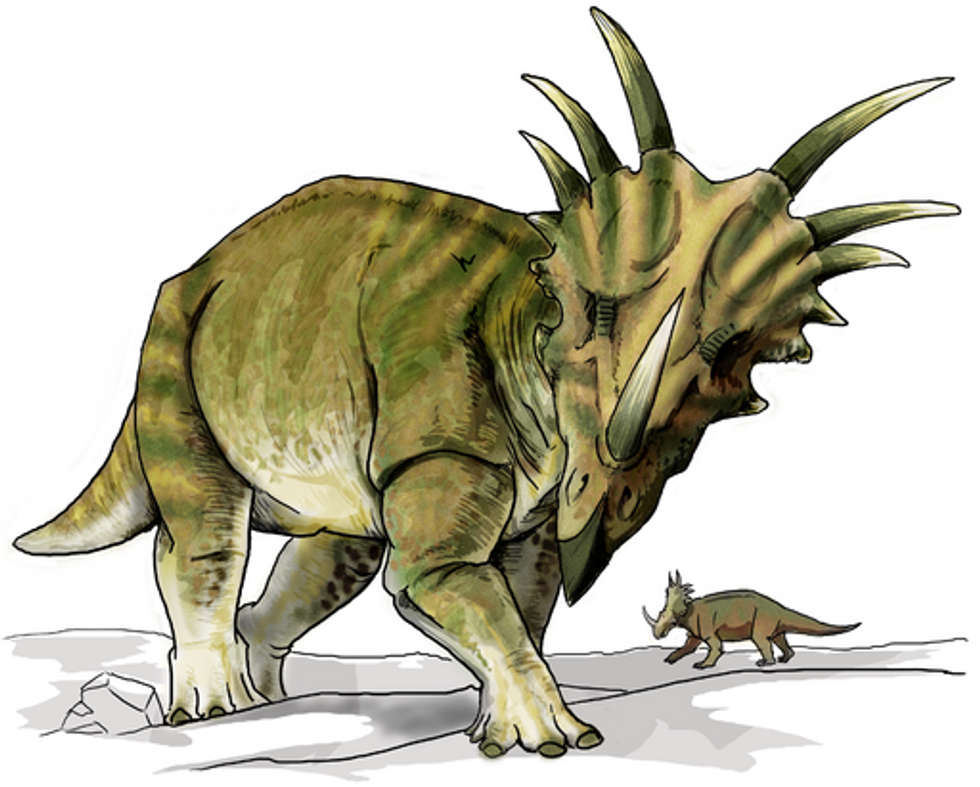Hamerkops are wading birds that forage food in shallow water. They are scientifically known as Scopus umbretta.
They are also known as hammerhead, hammerhead stork, umber bird, hammerkopf, and so on. It acquired its name from the shape of its head, curved bill, along with the back crest which resembles a hammer. They are highly distributed across South Africa, Arabia, South of Sahara and Madagascar.
It has dusky brown plumage and hints of iridescent purple on its back, and a weight between 415-430 g (14.5-15.05 oz), with a length of 18-22 in (46-57 cm) and large, broad wings. They are considered a family of water-birds, too, since they spend most of their time foraging for food in water.
Hamerkop are known to have big nests, and they built it on sturdy platforms for their safe habitat. Hamerkops have partially webbed feet, and is currently placed in the group of pelecaniformes or cormorant, even though it has been classified as Ciconiiformes.
Some of them migrate into a suitable habitat only during the wet season, but they are not considered migratory birds since migration for them occurs very rarely.
Want to know more about other bird species? You should check out stork and tawny owl too.
Hamerkop Interesting Facts
What type of animal is a hamerkop?
Hamerkops are birds of the order pelecaniformes, family scopidae and they are often referred to as wading birds or water birds.
What class of animal does a hamerkop belong to?
The hamerkop (Scopus umbretta) belongs to the Aves class of animal.
How many hamerkops are there in the world?
The total population of the hamerkop's species is undetermined. At present, they have a stable population and are spread across the world, especially in Africa, particularly Madagascar.
Where does a hamerkop live?
Given their preference to live near places with water, they are known to settle in wetlands, tropical rainforests, grasslands, and semi-forests.
Hamerkop nests are huge in size and big enough to fit the pairs and its hatchlings, which is why sometimes other birds like eagles and barn owls tend to take over their nests, but later can be claimed by the hamerkops.
They build their nest usually sited in the fork of a tree, often over a water since their diet mostly includes fish.
Built with sticks, grass, and reeds, their nests can weight up to 40-50 kg and stand strong in catastrophic situations.
What is a hamerkop's habitat?
The hamerkop bird is a unique wading bird species which is found abundantly in Africa. Hamerkop habitats are known to occur near shallow water from the banks of small streams to edges of large lakes.
They tend to be found in semi-arid plains, grasslands, and in costal regions on mudflats in mangrove swamps and estuaries.
They prefer wetland habitats including irrigated lands of rice fields. Hamerkops are keen to move in quickly when they spot new water bodies such as canals or dams and rare care about the water quality.
Who do hamerkops live with?
Hamerkops (Scopus genus) are generally seen in groups while foraging for food, but they nest alone or in pairs especially during the breeding season and with their young when they hatch.
Several hamerkop get together in groups and perform courtship displays or rituals by running around each other in circles, while raising their crest and calling out loudly with fluttering wings.
How long does a hamerkop live?
These wading birds have a lifespan up to 20 years in the wild. Many of their eggs and chicks are often preyed on by monitor lizards and snakes, so not all eggs hatch.
How do they reproduce?
Hermakops are remarkable wading birds known to build enormous nests as a pair, during the breeding season. Their breeding season occurs throughout the year, but peaks in the late rainy season.
Mating occurs while building their nests or after the pair builds it. However, mating between the pair is common even before building the nests. Female hamerkops can lay between 3-7 eggs.
Both the male and female hamerkops are known to take turns to incubate the eggs between 28-30 days. The hatchlings have broad bill and covered in grey down. The chicks' crest plumage and head develop when they are around 17 day sold, and are able to leave the nest after 40-50 days.
After hatching, the chicks roost in the nests at night for approximately two months. They are known to stay longer in the nest with their parents compared to other birds.
What is their conservation status?
The hamerkop's conservation status is Least Concern since they have a stable population, with no major threats.
Hamerkop Fun Facts
What do hamerkops look like?
This species of animal is medium sized, these wading birds are easy to identify. They weigh between 415-430 g (14.5-15.05 oz.) and have a length between 18-22 in (47-56 cm). They can be distinguished easily by its hammer shape head.
Their backs have hints of iridescent purple with brown plumage. The Hamerkop's have a long, flat bill and a short tail. They have broad, rounded, and large wings with a wingspan of 90-92 cm. Hamerkops acquire partially webbed feet and a comb-like middle toe to groom their feathers.
How cute are they?
Being a non-colorful bird that mostly lives in the wild, hamerkops may not be very appealing to all. But considering its caring nature towards its chicks, this certainly makes them a cute and caring bird.
How do they communicate?
Mostly, hamerkop sound silent when alone. This bird species is fairly vocal and loud when in groups or pairs. They make hamerkop calls by cackles and nasal rattles, and when alone they make a flight-call, a shrill 'kek' or 'nyip'.
How big is a hamerkop?
The length of a hamerkop ranges between 18-22 in (47-56 cm), and they are 15 times bigger than the Indian roller bird.
How fast can a hamerkop fly?
These soaring birds fly high while flapping their wings in a slow beat. They are partially a migratory bird, and considering their massive, strong broad wings, they have a good flight speed.
How much does a hamerkop weigh?
Hamerkops generally weigh between 415-430 g (14.5-15.05 oz.).
What are their male and female names of the species?
No separate names have been given to describe the male and female species of this bird.
What would you call a baby hamerkop?
The young of hamerkops are generally known as chicks.
What do they eat?
Hamerkop diet mainly consists of insects, small snakes, frogs, small fish.
Are they rare?
Hamerkops are quite commonly found in Africa, but rare in other regions. However, considering their Least Concern conservation status, they do not belong to a rare bird species, and can be found in abundance in wild wetlands.
Would they make a good pet?
This bird species is generally wild, this water bird prefer to stay in open wetlands, grasslands, forests, and forage their prey in water and flat mud areas, plus these birds feel more comfortable breeding in the wild.
The wild also has their prey available, making it better for their diet and weight, stabilising their behavior.
These birds would make a good pet theoretically, but having them as a pet and raising them at home may cause them huge concerns for their habitat and make them feel suffocated, affecting their behavior, diet, among other things, as these birds like to find their prey, like fish, themselves.
Did you know...
These are the smallest African stork animals.
Hamerkops are known to have a very strange behavior unlike other bird species. These birds get together in their hamerkop habitat as a group to perform courtship displays or rituals which involves running in circles around each other, while raising their crests, fluttering their wings, accompanied by louds calls.
Hamerkops also has an unusual social behavior known as 'false mounting' which involves one bird standing on top of the other and appearing to mate, but the hamerkop bird does not actually mate in this instance.
How did the hamerkop get its name?
The hamerkop etymology consists of the African hamerkop, from hamer, meaning hammer and cop meaning head. It got its name from its hammer shape head.
How to pronounce hamerkop?
Hamerkop pronunciation consist of 'hammer' and 'cop', or 'ham' 'mer' 'cop'.
Here at Kidadl, we have carefully created lots of interesting family-friendly animal facts for everyone to discover! Learn more about some other birds including tawny eagle, or Indian roller.
You can even occupy yourself at home by drawing one on our Hamerkop coloring pages.










